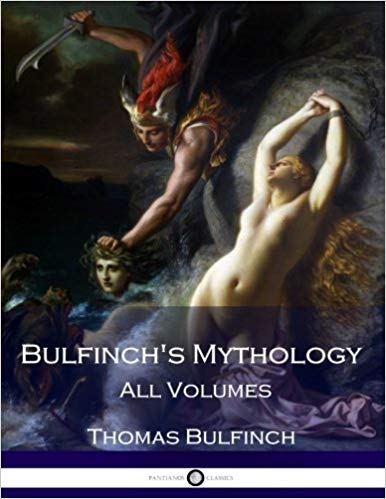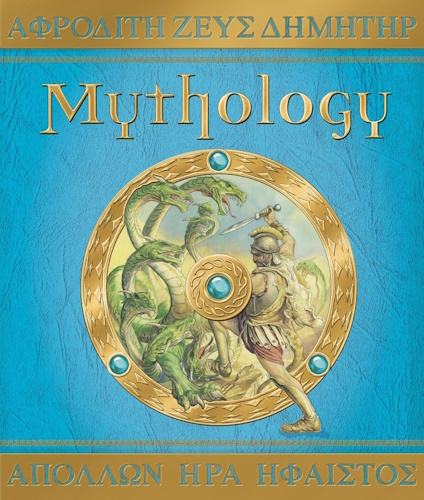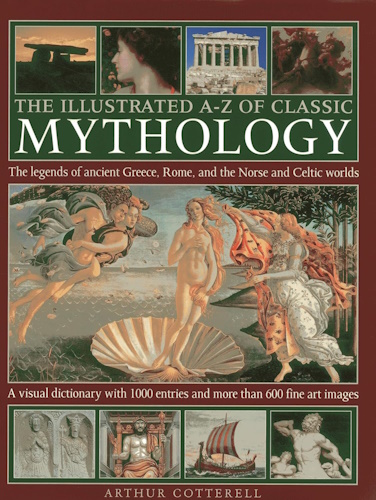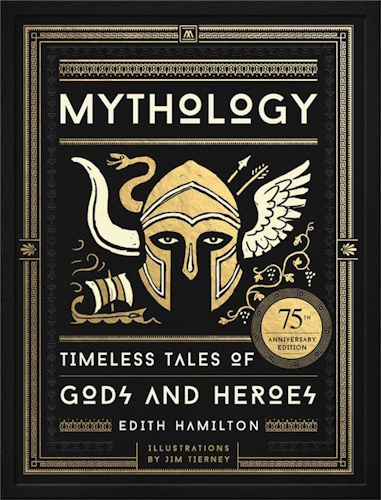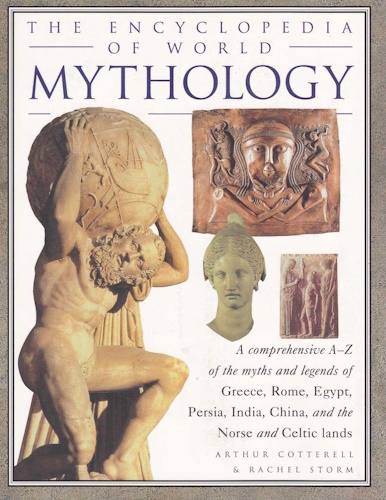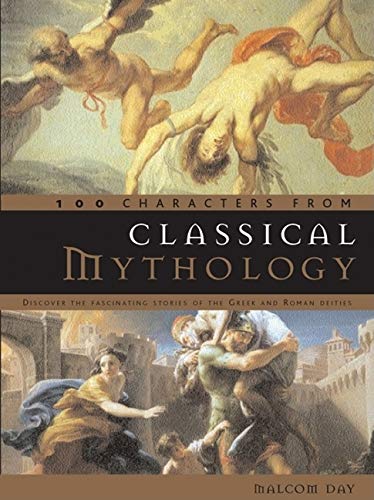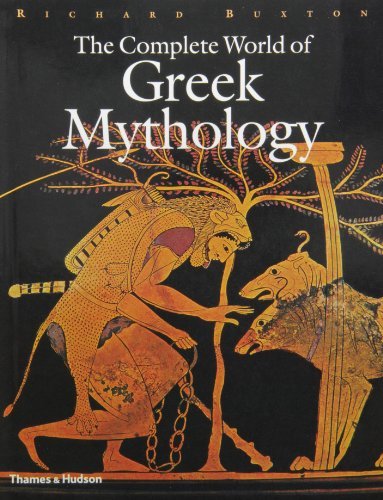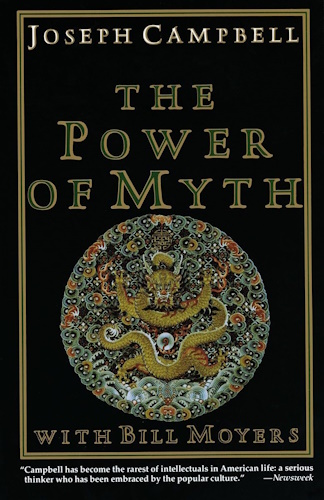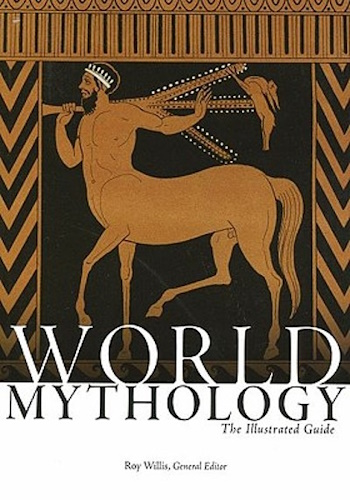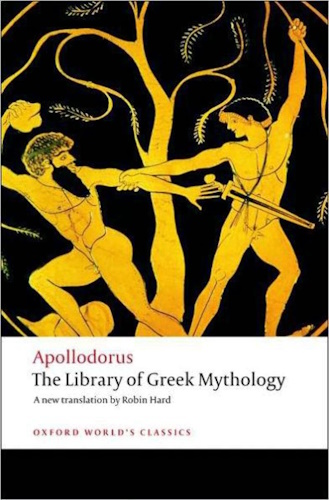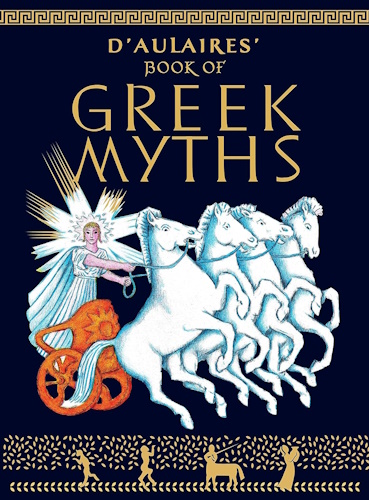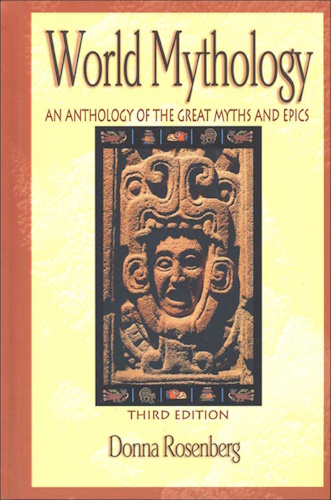
![]()
![]()
Part III.
Hero Myths of the British Race.
BEOWULF.
Notable among the names of heroes of the British race is that of Beowulf, which appeals to all English-speaking people in a very special way, since he is the one hero in whose story we may see the ideals of our English forefathers before they left their Continental home to cross to the islands of Britain.
Although this hero had distinguished himself by numerous feats of strength during his boyhood and early youth, it was as the deliverer of Hrothgar, king of Denmark, from the monster Grendel that he first gained wide renown. Grendel was half monster and half man, and had his abode in the fen-fastnesses in the vicinity of Hrothgar's residence. Night after night he would steal into the king's great palace called Heorot and slay sometimes as many as thirty at one time of the knights sleeping there.
Beowulf put himself at the head of a selected band of warriors, went against the monster, and after a terrible fight slew it. The following night Grendel's mother, a fiend scarcely less terrible than her son, carried off one of Hrothgar's boldest thanes. Once more Beowulf went to the help of the Danish king, followed the she-monster to her lair at the bottom of a muddy lake in the midst of the swamp, and with his good sword Hrunting and his own muscular arms broke the sea-woman's neck.
Upon his return to his own country of the Geats, loaded with honors bestowed upon him by Hrothgar, Beowulf served the king of Geatland as the latter's most trusted counsellor and champion. When, after many years, the king fell before an enemy, the Geats unanimously chose Beowulf for their new king. His fame as a warrior kept his country free from invasion, and his wisdom as a statesman increased its prosperity and happiness.
In the fiftieth year of Beowulf's reign, however, a great terror fell upon the land in the way of a monstrous fire-dragon, which flew forth by night from its den in the rocks, lighting up the blackness with its blazing breath, and burning houses and homesteads, men and cattle, with the flames from its mouth. When the news came to Beowulf that his people were suffering and dying, and that no warrior dared to risk his life in an effort to deliver the country from this deadly devastation, the aged king took up his shield and sword and went forth to his last fight. At the entrance of the dragon's cave Beowulf raised his voice and shouted a furious defiance to the awesome guardian of the den. Roaring hideously and napping his glowing wings together, the dragon rushed forth and half flew, half sprang, on Beowulf. Then began a fearful combat, which ended in Beowulf's piercing the dragon's scaly armor and inflicting a mortal wound, but alas! in himself being given a gash in the neck by his opponent's poisoned fangs which resulted in his death. As he lay stretched on the ground, his head supported by Wiglaf, an honored warrior who had helped in the fight with the dragon, Beowulf roused himself to say, as he grasped Wiglaf's hand:
"Thou must now look to the needs of the nation;
Here dwell I no longer, for Destiny calleth me!
Bid thou my warriors after my funeral pyre
Build me a burial-cairn high on the sea-cliff's head;
So that the seafarers Beowulf's Barrow
Henceforth shall name it, they who drive far and wide
Over the mighty flood their foamy keels.
Thou art the last of all the kindred of Wagmund!
Wyrd has swept all my kin, all the brave chiefs away!
Now must I follow them!"
These last words spoken, the king of the Geats, brave to seek danger and brave to look on death and Fate undaunted, fell back dead. According to his last desires, his followers gathered wood and piled it on the cliff-head. Upon this funeral pyre was laid Beowulf's body and consumed to ashes. Then, upon the same cliff of Hronesness, was erected a huge burial cairn, wide-spread and lofty, to be known thereafter as Beowulf's Barrow.
CUCHULAIN, CHAMPION OF IRELAND
Among all the early literatures of Europe, there are two which, at exactly opposite corners of the continent, display most strikingly similar characteristics. These are the Greek and the Irish, and the legend of the Irish champion Cuchulain, which well illustrates the similarity of the literatures, bears so close a resemblance to the story of Achilles as to win for this hero the title of "the Irish Achilles." Certainly in reckless courage, power of inspiring dread, sense of personal merit, and frankness of speech the Irish hero is fully equal to the mighty Greek.
Cuchulain was the nephew of King Conor of Ulster, son of his sister Dechtire, and it is said that his father was no mortal man, but the great god Lugh of the Long Hand. Cuchulain was brought up by King Conor himself, and even while he was still a boy his fame spread all over Ireland. His warlike deeds were those of a proved warrior, not of a child of nursery age; and by the time Cuchulain was seventeen he was without peer among the champions of Ulster.
Upon Cuchulain's marriage to Emer, daughter of Forgall the Wily, a Druid of great power, the couple took up their residence at Armagh, the capital of Ulster, under the protection of King Conor. Here there was one chief, Bricriu of the Bitter Tongue, who, like Thersites among the Grecian leaders, delighted in making mischief. Soon he had on foot plans for stirring up strife among the heroes of Ulster, leaders among whom were the mighty Laegaire, Conall Cearnach, cousin of Cuchulain, and Cuchulain himself. Inviting the members of King Conor's court to dinner, Bricriu arranged that a contest should arise over who should have the "champion's portion," and so successful was he that, to avoid a bloody fight, the three heroes mentioned decided to submit their claims to the championship of Ireland to King Ailill of Connaught.
Ailill put the heroes to an unexpected test. Their dinner was served them in a separate room, into which three magic beasts, in the shape of monstrous cats, were sent by the king. When they saw them Laegire and Conall rose from their meal, climbed among the rafters, and stayed there all night. Cuchulain waited until one cat attacked him, and then, drawing his sword, struck the monster. It showed no further sign of fight, and at daybreak the magic beasts disappeared.
As Laegire and Conall claimed that this test was an unfair one, Ailill sent the three rivals to Curoi of Kerry, a just and wise man, who set out to discover by wizardry and enchantments the best among the heroes. In turn they stood watch outside Curoi's castle, where Laegire and Conall were overcome by a huge giant, who hurled spears of mighty oak trees, and ended by throwing them over the wall into the courtyard. Cuchulain alone withstood the giant, whereupon he was attacked by other magic foes. Among these was a dragon, which flew on horrible wings from a neighboring lake, and seemed ready to devour everything in its way. Cuchulain sprang up, giving his wonderful hero-leap, thrust his arm into the dragon's mouth and down its throat, and tore out its heart. After the monster fell dead, he cut off its scaly head.
As even yet Cuchulain's opponents would not admit his championship, they were all three directed to return to Armagh, to await Curoi's judgment. Here it happened that all the Ulster heroes were in the great hall one night, except Cuchulain and his cousin Conall. As they sat in order of rank, a terrible stranger, gigantic in stature, hideous of aspect, with ravening yellow eyes, entered. In his hand he bore an enormous axe, with keen and shining edge. Upon King Conor's inquiring his business there, the stranger replied:
"Behold my axe! The man who will grasp it to-day may cut my head off with it, provided that I may, in like manner, cut off his head to-morrow. If you have no champion who dare face me, I will say that Ulster has lost her courage and is dishonored."
At once Laegire accepted the challenge. The giant laid his head on a block, and at a blow the hero severed it from the body. Thereupon the giant arose, took the head and the axe, and thus, headless, strode from the hall. But the following night, when he returned, sound as ever, to claim the fulfilment of Laegire's promise, the latter's heart failed him and he did not come forward. The stranger then jeered at the men of Ulster because their great champion durst not keep his agreement, nor face the blow he should receive in return for the one he gave.
The men of Ulster were utterly ashamed, but Conall Cearnach, who was present that night, made a new agreement with the stranger. He gave a blow which beheaded the giant, but again, when the latter returned whole and sound on the following evening, the champion was not to be found.
Now it was the turn of Cuchulain, who, as the others had done, cut off the giant's head at one stroke. The next day the members of Conor's court watched Cuchulain to see what he would do. They would not have been surprised if he had failed like the others, who now were present. The champion, however, showed no signs of failing or retreat. He sat sorrowfully in his place, and with a sigh said to King Conor as they waited: "Do not leave this place till all is over. Death is coming to me very surely, but I must fulfil my agreement, for I would rather die than break my word."
Towards the close of day the stranger strode into the hall exultant.
"Where is Cuchulain?" he cried.
"Here I am," was the reply.
"Ah, poor boy! your speech is sad to-night, and the fear of death lies heavy on you; but at least you have redeemed your word and have not failed me."
The youth rose from his seat and went towards him, as he stood with the great axe ready, and knelt to receive the blow.
The hero of Ulster laid his head on the block; but the giant was not satisfied. "Stretch out your neck better," said he.
"You are playing with me, to torment me," said Cuchulain. "Slay me now speedily, for I did not keep you waiting last night."
However, he stretched out his neck as ordered, and the stranger raised his axe till it crashed upwards through the rafters of the hall, like the crash of trees falling in a storm. When the axe came down with a terrific sound all men looked fearfully at Cuchulain. The descending axe had not even touched him; it had come down with the blunt side on the ground, and the youth knelt there unharmed. Smiling at him, and leaning on his axe, stood no terrible and hideous stranger, but Curoi of Kerry, come to give his decision at last.
"Rise up, Cuchulain," said Curoi. "There is none among all the heroes of Ulster to equal you in courage and loyalty and truth. The Championship of the Heroes of Ireland is yours from this day forth, and the Champion's Portion at all feasts; and to your wife I adjudge the first place among all the women of Ulster. Woe to him who dares to dispute this decision!" Thereupon Curoi vanished, and the warriors gathered around Cuchulain, and all with one voice acclaimed him the Champion of the Heroes of all Ireland—a title which has clung to him until this day.
This is one of many stories told of the Irish champion, whose deeds of bravery would fill many pages. Cuchulain finally came to his end on the field of battle, after a fight in which he displayed all his usual gallantry but in which unfair means were used to overcome him.
For Wales and for England during centuries Arthur has been the representative "very gentle perfect knight." In a similar way, in England's sister isle, Cuchulain stands ever for the highest ideals of the Irish Gaels.
HEREWARD THE WAKE
In Hereward the Wake (or "Watchful") is found one of those heroes whose date can be ascertained with a fair amount of exactness and yet in whose story occur mythological elements which seem to belong to all ages. The folklore of primitive races is a great storehouse whence a people can choose tales and heroic deeds to glorify its own national hero, careless that the same tales and deeds have done duty for other peoples and other heroes. Hence it happens that Hereward the Saxon, a patriot hero as real and actual as Nelson or George Washington, whose deeds were recorded in prose and verse within forty years of his death, was even then surrounded by a cloud of romance and mystery, which hid in vagueness his family, his marriage, and even his death.
Briefly it may be stated that Hereward was a native of Lincolnshire, and was in his prime about 1070. In that year he joined a party of Danes who appeared in England, attacked Peterborough and sacked the abbey there, and afterward took refuge in the Isle of Ely. Here he was besieged by William the Conqueror, and was finally forced to yield to the Norman. He thus came to stand for the defeated Saxon race, and his name has been passed down as that of the darling hero of the Saxons. For his splendid defence of Ely they forgave his final surrender to Duke William; they attributed to him all the virtues supposed to be inherent in the free-born, and all the glorious valor on which the English prided themselves; and, lastly, they surrounded his death with a halo of desperate fighting, and made his last conflict as wonderful as that of Roland at Roncesvalles. If Roland is the ideal of Norman feudal chivalry, Hereward is equally the ideal of Anglo-Saxon sturdy manliness and knighthood.
An account of one of Hereward's adventures as a youth will serve as illustration of the stories told of his prowess. On an enforced visit to Cornwall, he found that King Alef, a petty British chief, had betrothed his fair daughter to a terrible Pictish giant, breaking off, in order to do it, her troth-plight with Prince Sigtryg of Waterford, son of a Danish king in Ireland. Hereward, ever chivalrous, picked a quarrel with the giant and killed him in fair fight, whereupon the king threw him into prison. In the following night, however, the released princess arranged that the gallant Saxon should be freed and sent hot-foot for her lover, Prince Sigtryg. After many adventures Hereward reached the prince, who hastened to return to Cornwall with the young hero. But to the grief of both, they learned upon their arrival that the princess had just been betrothed to a wild Cornish hero, Haco, and the wedding feast was to be held that very day. Sigtryg at once sent a troop of forty Danes to King Alef demanding the fulfilment of the troth-plight between himself and his daughter, and threatening vengeance if it were broken. To this threat the king returned no answer, and no Dane came back to tell of their reception.
Sigtryg would have waited till morning, trusting in the honor of the king, but Hereward disguised himself as a minstrel and obtained admission to the bridal feast, where he soon won applause by his beautiful singing. The bridegroom, Haco, in a rapture offered him any boon he liked to ask, but he demanded only a cup of wine from the hands of the bride. When she brought it to him he flung into the empty cup the betrothal ring, the token she had sent to Sigtryg, and said: "I thank thee, lady, and would reward thee for thy gentleness to a wandering minstrel; I give back the cup, richer than before by the kind thoughts of which it bears the token." The princess looked at him, gazed into the goblet, and saw her ring; then, looking again, she recognized her deliverer and knew that rescue was at hand.
While men feasted Hereward listened and talked, and found out that the forty Danes were prisoners, to be released on the morrow when Haco was sure of his bride, but released useless and miserable, since they would be turned adrift blinded. Haco was taking his lovely bride back to his own land, and Hereward saw that any rescue, to be successful, must be attempted on the march.
Returning to Sigtryg, the young Saxon told all that he had learned, and the Danes planned an ambush in the ravine where Haco had decided to blind and set free his captives. The whole was carried out exactly as Hereward arranged it. The Cornishmen, with the Danish captives, passed first without attack; next came Haco, riding grim and ferocious beside his silent bride, he exulting in his success, she looking eagerly for any signs of rescue. As they passed Hereward sprang from his shelter, crying, "Upon them, Danes, and set your brethren free!" and himself struck down Haco and smote off his head. There was a short struggle, but soon the rescued Danes were able to aid their deliverers, and the Cornish guards were all slain; the men of King Alef, never very zealous for the cause of Haco, fled, and the Danes were left masters of the field.
Sigtryg had in the meantime seen to the safety of the princess, and now, placing her between himself and Hereward, he escorted her to the ship, which soon brought them to Waterford and a happy bridal. The Prince and Princess of Waterford always recognized in Hereward their deliverer and best friend, and in their gratitude wished him to dwell with them always; but the hero's roving and daring temper forbade his settling down, but rather urged him on to deeds of arms in other lands, where he quickly won a renown second to none.
ROBIN HOOD
Among the earliest heirlooms of the Anglo-Saxon tongue are the songs and legends of Robin Hood and his merry outlaws, which have charmed readers young and old for more than six hundred years. These entertaining stories date back to the time when Chaucer wrote his "Canterbury Tales," when the minstrel and scribe stood in the place of the more prim and precise modern printed book.
The question of whether or not Robin Hood was a real person has been asked for many years, just as a similar question has been asked about William Tell and others whom everyone would much rather accept on faith. It cannot be answered by a brief "yes" or "no," even though learned men have pored over ancient records and have written books on the subject. According to the general belief Robin was an outlaw in the reign of Richard I, when in the depths of Sherwood Forest he entertained one hundred tall men, all good archers, with the spoil he took; but "he suffered no woman to be oppressed or otherwise molested; poore men's goods he spared, abundantlie relieving them with that which by theft he got from abbeys and houses of rich carles." Consequently Robin was an immense favorite with the common people.
This popularity extended from the leader to all the members of his hardy band. "God save Robin Hood and all his good yeomanry" is the ending of many old ballads. The clever archer who could outshoot his fellows, the brave yeoman inured to blows, and the man who could be true to his friends through thick and thin were favorites for all time; and they have been idealized in the persons of Robin Hood and his merry outlaws.
One of the best-known stories of this picturesque figure of early English times is that given by Sir Walter Scott in "Ivanhoe," concerning the archery contest during the rule or misrule of Prince John, in the absence of Richard from the kingdom. Robin Hood, under the assumed name of Locksley, boldly presents himself at a royal tournament at Ashby, as competitor for the prize in shooting with the long-bow. From the eight or ten archers who enter the contest, the number finally narrows down to two,— Hubert, a forester in the service of one of the king's nobles, and Locksley or Robin Hood. Hubert takes the first shot in the final trial of skill, and lands his arrow within the inner ring of the target, but not exactly in the centre.
"'You have not allowed for the wind, Hubert,' said Locksley, 'or that had been a better shot.'
"So saying, and without showing the least anxiety to pause upon his aim, Locksley stepped to the appointed station, and shot his arrow as carelessly in appearance as if he had not even looked at the mark. He was speaking almost at the instant that the shaft left the bow-string, yet it alighted in the target two inches nearer to the white spot which marked the centre than that of Hubert.
"'By the light of Heaven!' said Prince John to Hubert, 'an thou suffer that runagate knave to overcome thee, thou art worthy of the gallows!'
"Hubert had but one set speech for all occasions. 'An your highness were to hang me,' he said, 'a man can but do his best. Nevertheless, my grandsire drew a good bow—'
"'The foul fiend on thy grandsire and all his generation!' interrupted John; 'shoot, knave, and shoot thy best, or it shall be worse for thee!'
"Thus exhorted, Hubert resumed his place, and not neglecting the caution which he had received from his adversary, he made the necessary allowance for a very light air of wind, which had just risen, and shot so successfully that his arrow alighted in the very centre of the target.
"'A Hubert! a Hubert!' shouted the populace, more interested in a known person than in a stranger. 'In the clout!—in the clout!—a Hubert forever!'
"'Thou canst not mend that shot, Locksley,' said the Prince, with an insulting smile.
"'I will notch his shaft for him, however,' replied Locksley.
"And letting fly his arrow with a little more precaution than before, it lighted right upon that of his competitor, which it split to shivers. The people who stood around were so astonished at his wonderful dexterity, that they could not even give vent to their surprise in their usual clamor. 'This must be the devil, and no man of flesh and blood,' whispered the yeomen to each other; 'such archery was never seen since a bow was first bent in Britain.'
"'And now,' said Locksley, 'I will crave your Grace's permission to plant such a mark as is used in the North Country; and welcome every brave yeoman who shall try a shot at it to win a smile from the bonny lass he loves best.'"
Locksley thereupon sets up a willow wand, six feet long and as thick as a man's thumb. Hubert is forced to decline the honor of taking part in such a trial of archery skill, but his rival easily splits the wand at a distance of three hundred feet and carries off the prize.
"Even Prince John, in admiration of Locksley's skill, lost for an instant his dislike to his person. 'These twenty nobles,' he said, 'which, with the bugle, thou hast fairly won, are thine own; we will make them fifty, if thou wilt take livery and service with us as a yeoman of our bodyguard, and be near to our person. For never did so strong a hand bend a bow, or so true an eye direct a shaft.'" [Footnote: Ivanhoe, Vol. 1, chap. XIII.]
Locksley, however, declares that it is impossible for him to enter the Prince's service, generously shares his prize with the worthy Hubert, and retires once more to his beloved haunts among the lights and shadows of the good greenwood.
-
Urantia Book, 44:0.11 - The Celestial Artisans
Never in your long ascendancy will you lose the power to recognize your associates of former existences. Always, as you ascend inward in the scale of life, will you retain the ability to recognize and fraternize with the fellow beings of your previous and lower levels of experience. Each new translation or resurrection will add one more group of spirit beings to your vision range without in the least depriving you of the ability to recognize your friends and fellows of former estates.
-
Princess Bride 1987 Wallace Shawn (Vizzini) and Mandy Patinkin (Inigo Montoya)
Vizzini: HE DIDN'T FALL? INCONCEIVABLE.
Inigo Montoya: You keep using that word. I do not think it means what you think it means. -
Urantia Book, 117:4.14 - The Finite God
And here is mystery: The more closely man approaches God through love, the greater the reality -- actuality -- of that man. The more man withdraws from God, the more nearly he approaches nonreality -- cessation of existence. When man consecrates his will to the doing of the Father's will, when man gives God all that he has, then does God make that man more than he is.
-
Urantia Book, 167:7.4 - The Talk About Angels
"And do you not remember that I said to you once before that, if you had your spiritual eyes anointed, you would then see the heavens opened and behold the angels of God ascending and descending? It is by the ministry of the angels that one world may be kept in touch with other worlds, for have I not repeatedly told you that I have other sheep not of this fold?"
-
Urantia Book, Foreword - 0:12.12 - The Trinities
But we know that there dwells within the human mind a fragment of God, and that there sojourns with the human soul the Spirit of Truth; and we further know that these spirit forces conspire to enable material man to grasp the reality of spiritual values and to comprehend the philosophy of universe meanings. But even more certainly we know that these spirits of the Divine Presence are able to assist man in the spiritual appropriation of all truth contributory to the enhancement of the ever-progressing reality of personal religious experience—God-consciousness.
-
Urantia Book, 1:4.3 - The Mystery Of God
When you are through down here, when your course has been run in temporary form on earth, when your trial trip in the flesh is finished, when the dust that composes the mortal tabernacle "returns to the earth whence it came"; then, it is revealed, the indwelling "Spirit shall return to God who gave it." There sojourns within each moral being of this planet a fragment of God, a part and parcel of divinity. It is not yet yours by right of possession, but it is designedly intended to be one with you if you survive the mortal existence.
-
Urantia Book, 1:4.1 - The Mystery Of God
And the greatest of all the unfathomable mysteries of God is the phenomenon of the divine indwelling of mortal minds. The manner in which the Universal Father sojourns with the creatures of time is the most profound of all universe mysteries; the divine presence in the mind of man is the mystery of mysteries.
-
Urantia Book, 1:4.6 - The Mystery Of God
To every spirit being and to every mortal creature in every sphere and on every world of the universe of universes, the Universal Father reveals all of his gracious and divine self that can be discerned or comprehended by such spirit beings and by such mortal creatures. God is no respecter of persons, either spiritual or material. The divine presence which any child of the universe enjoys at any given moment is limited only by the capacity of such a creature to receive and to discern the spirit actualities of the supermaterial world.
-
Urantia Book, 11:0.1 - The Eternal Isle Of Paradise
Paradise is the eternal center of the universe of universes and the abiding place of the Universal Father, the Eternal Son, the Infinite Spirit, and their divine co-ordinates and associates. This central Isle is the most gigantic organized body of cosmic reality in all the master universe. Paradise is a material sphere as well as a spiritual abode. All of the intelligent creation of the Universal Father is domiciled on material abodes; hence must the absolute controlling center also be material, literal. And again it should be reiterated that spirit things and spiritual beings are real.
-
Urantia Book, 50:6.4 - Planetary Culture
Culture presupposes quality of mind; culture cannot be enhanced unless mind is elevated. Superior intellect will seek a noble culture and find some way to attain such a goal. Inferior minds will spurn the highest culture even when presented to them ready-made.
-
Urantia Book, 54:1.6 - True And False Liberty
True liberty is the associate of genuine self-respect; false liberty is the consort of self-admiration. True liberty is the fruit of self-control; false liberty, the assumption of self-assertion. Self-control leads to altruistic service; self-admiration tends towards the exploitation of others for the selfish aggrandizement of such a mistaken individual as is willing to sacrifice righteous attainment for the sake of possessing unjust power over his fellow beings.
-
Urantia Book, 54:1.9 - True And False Liberty
How dare the self-willed creature encroach upon the rights of his fellows in the name of personal liberty when the Supreme Rulers of the universe stand back in merciful respect for these prerogatives of will and potentials of personality! No being, in the exercise of his supposed personal liberty, has a right to deprive any other being of those privileges of existence conferred by the Creators and duly respected by all their loyal associates, subordinates, and subjects.
-
Urantia Book, 54:1.8 - True And False Liberty
There is no error greater than that species of self-deception which leads intelligent beings to crave the exercise of power over other beings for the purpose of depriving these persons of their natural liberties. The golden rule of human fairness cries out against all such fraud, unfairness, selfishness, and unrighteousness.
